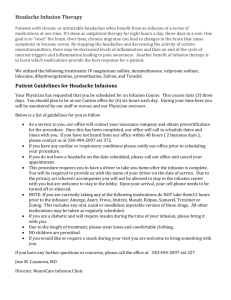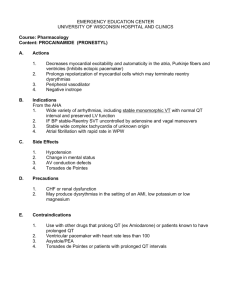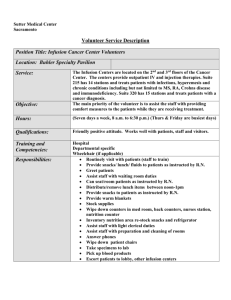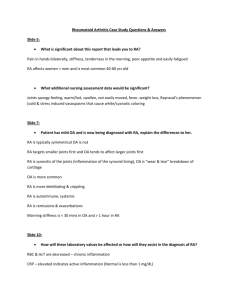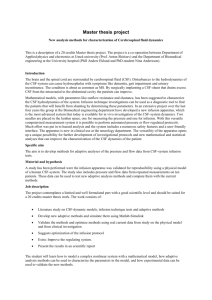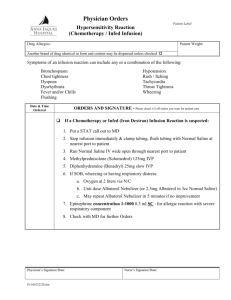INTRODUCTION
advertisement
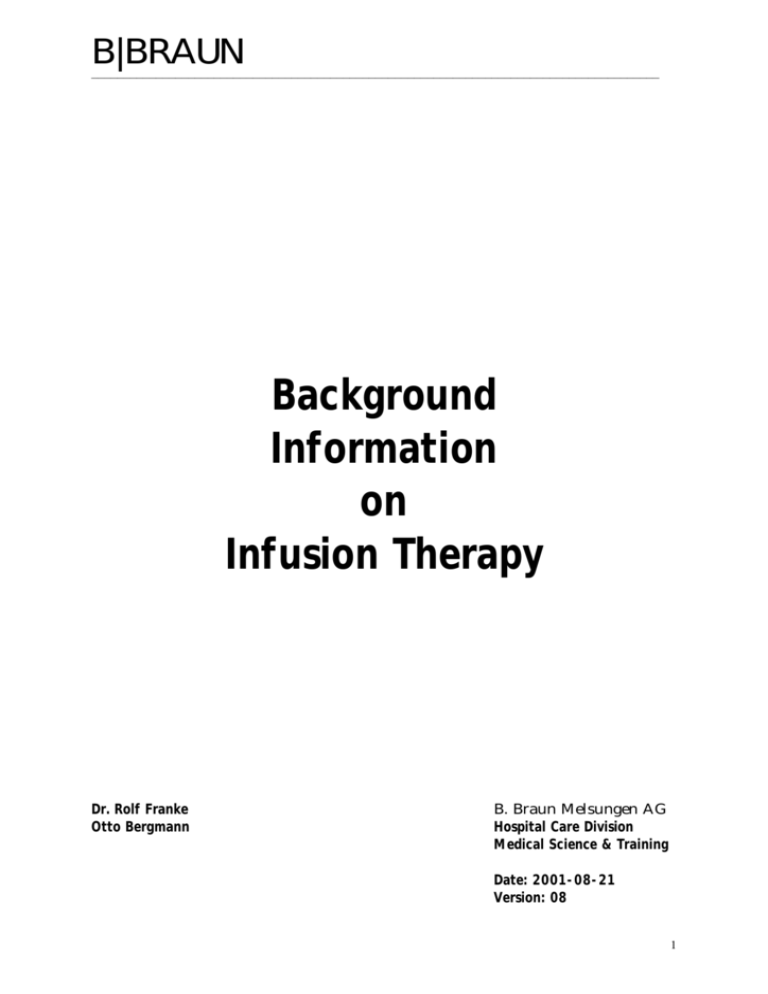
B|BRAUN ________________________________________________________________________________________ Background Information on Infusion Therapy Dr. Rolf Franke Otto Bergmann B. Braun Melsungen AG Hospital Care Division Medical Science & Training Date: 2001-08-21 Version: 08 1 B|BRAUN ________________________________________________________________________________________ INTRODUCTION INFUSION THERAPY AND B|BRAUN While in the USA the development of Infusion therapy was characterised by names like Donald Baxter or Foster McGaw, in Germany it was inseparably associated with Dr. Bernd Braun and consequently with B. Braun Melsungen AG. In the field of infusion solutions comprising trade-marks as Stereofundin® or Plasco® as well as with the introduction of medical products such as Braunula®, Intrafix® and Perfusor®, B|BRAUN set milestones in the development of application techniques that have nowadays become routine. Also with regard to economical aspects, the development of infusion therapy is closely connected to the rise of the company to one of the leading hospital suppliers in Europe since more than half of the total turnover is achieved by sales out of the various product lines for infusion therapy. HISTORICAL DEVELOPMENT The discovery of the blood circulation by William HARVEY in 1628, reported in his "Exercitatio anatomica de motu cordis es sanguinis in animalibus" served as the physiological-anatomical basis for the clinical use of intravenous injection, infusion and transfusion. The first practical injection trials in animals were, however, not carried out by physicians, but rather by laymen. The cavalry captain, VAN WAHRENDORF, injected wine into the veins of his hunting dogs and observed the typical symptoms of drunkenness in them. Further trials are reported from England. WREN carried out intravenous injections in animals in 1656, WREN, BOYLE and CLARKE continued these experiments in the following years, using a small tube to which an animal bladder was attached. The substances injected included among others water, wine, milk, beer, opium solutions, meat bouillon, emetics. The physicians Johann Sigismund ELSHOLTZ, Johann Daniel MAJOR and Michael ETTMÜLLER introduced the technique of intravenous application of drugs for therapeutic purposes in Germany. In 1657 Robert BOYLE carried out the first blood transfusion followed by Jean DENIS in 1667. While in the first case blood was transfused from one animal to another the second one was the very first case where a sheep’s blood was transfused to a human being (fig. 1). Further descriptions were provided by LOWER and KING, 1667 and GAYANT, 1667/1668. In the 18th century intravenous injections were carried out 2 B|BRAUN ________________________________________________________________________________________ in physiological and pharmacological trials as well as for therapeutic purposes, however, without the final medical breakthrough being yet to come. Though some very few cases of successful injection were reported, the side effects acted as a significant deterrent. All in all, the medical profession remained rather reticent during the first half of the 19th century. Though bloodletting, rectal syringes and cannulae had been known since antiquity, the technique of intravenous injection had posed a major problem to the physicians since the 17th century as can be gathered from the variety of methods recommended. The most serious problem to cope with was how to inject fluid into the vein of a patient through the bloodletting wound used for this purpose. The English surgeon HUNTER is reported to have mentioned a sharpened hollow needle for the first time in 1830. During the second half of the 19th century, the newly invented technique gave the first major impetus to the method of intravenous injection for therapeutic use. In 1853 Karl PRAVAZ described a glass syringe with a hollow needle attached to it. The piston was driven forward by means of a thread. He tried to thrombose the aneurysm of a peripheral artery by injecting iron chloride. In 1858 WOOD published a report on a graduated glass syringe to which a thin, hollow needle was attached. In 1869, LUER constructed a piston syringe made of glass with a cone for attaching the needle. In 1881 LANDERER finally succeeded in introducing the method of intravenous injection to clinical practise by using the PRAVAZ syringe. He recommended a technique that did not involve prior venae section to expose the vein, but to puncture it through the intact skin following compression. The discovery of the blood groups by Karl LANDSTEINER in 1901 also provided the basis for modern blood transfusion. In 1906 the record syringe, made of glass and metal, was introduced in Germany. Administration of drugs by way of infusion, however, did not become a commonly used technique until Albert FRÄNKEL introduced strophanthin in 1906 and Paul EHRLICH introduced salvarsan in 1910. The therapeutic use of these two drugs contributed to physicians becoming familiar with the method of intravenous injection. While shortly after the second world war infusions were still carried out only in cases of severe illness, often using self-made devices, they are nowadays one of the indispensable therapeutic methods in modern clinical practice. Since 1960 single-use articles meeting the highest technical standards and medical requirements have replaced multiple-use products for reasons of hygiene and rationalisation. With these new products, an i.v. infusion requires only little more effort than any other i.v. injection. 3 B|BRAUN ________________________________________________________________________________________ INFUSION THERAPY TODAY Today infusion therapy is of considerable importance in intensive-care medicine, serving as a method for the intake of water, electrolytes, blood and substrates. It is also used for the intravascular administration of drugs as well as for diagnostics. The parenteral administration of drugs is thus a routine form of application in clinical therapy. In modern intensive care medicine, for example, the patient receives parenteral nutrition as well as all drugs which are necessary for treatment by way of a central line catheter. All in all, infusion therapy plays a highly important role in modern medicine. In particular, clinical anaesthesia, reanimation, intensive care therapy and emergency medicine would not be possible without it. 4 B|BRAUN ________________________________________________________________________________________ PURPOSE OF THE LECTURE NOTES The lecture notes “Background Information on INFUSION THERAPY” are designed for training internal B|BRAUN staff as a means of preparation prior to the seminar. Two goals are important here: On the one hand, learning beforehand shall establish a common level of knowledge among the participants so that during the seminar attention can be focused on practical examples. On the other hand, when working through the notes, individual gaps of knowledge can be found that will be eliminated during the seminar. The lecture notes could help healthcare professionals to prepare their own lectures or students to understand the principles of infusion therapy. STRUCTURE OF THE LECTURE NOTES The present lecture notes are divided into two sections. The first part comprises background information on biological structures and the function of the body. This basic knowledge is indispensable for the understanding of infusion therapy. The second part finally deals with the essential elements of infusion therapy serving as a lead-in to the complex field of this therapy . As these lecture notes should serve as a learning tool, they include some elements which support the learning process. ! The training objectives stated at the beginning of each chapter give an overview of the material that shall be worked through in this chapter. ! At the end of the chapters there are comprehension questions which help to control one’s own learning success ! In the annex of the script you will find a glossary giving the most important technical terms. The terms explained in the glossary are underlined in the text. 5
